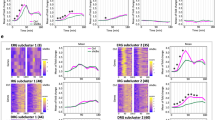Abstract
NF-κB is a principal transcriptional regulator of diverse cytokine-mediated processes and is tightly controlled by the IκB kinase complex (IKK-α/β/γ). IKK-β and IKK-γ are critical for cytokine-induced NF-κB function, whereas IKK-α is thought to be involved in other regulatory pathways1,2,3,4. However, recent data suggest a role for IKK-α in NF-κB-dependent gene expression in response to cytokine treatment1,5,6,7. Here we demonstrate nuclear accumulation of IKK-α after cytokine exposure, suggesting a nuclear function for this protein. Consistent with this, chromatin immunoprecipitation (ChIP) assays reveal that IKK-α was recruited to the promoter regions of NF-κB-regulated genes on stimulation with tumour-necrosis factor-α. Notably, NF-κB-regulated gene expression is suppressed by the loss of IKK-α and this correlates with a complete loss of gene-specific phosphorylation of histone H3 on serine 10, a modification previously associated with positive gene expression. Furthermore, we show that IKK-α can directly phosphorylate histone H3 in vitro, suggesting a new substrate for this kinase. We propose that IKK-α is an essential regulator of NF-κB-dependent gene expression through control of promoter-associated histone phosphorylation after cytokine exposure. These findings provide additional insight into the role of the IKK complex in NF-κB-regulated gene expression.
This is a preview of subscription content, access via your institution
Access options
Subscribe to this journal
Receive 51 print issues and online access
$199.00 per year
only $3.90 per issue
Buy this article
- Purchase on Springer Link
- Instant access to full article PDF
Prices may be subject to local taxes which are calculated during checkout




Similar content being viewed by others
References
Ghosh, S. & Karin, M. Missing pieces in the NF-κB puzzle. Cell 109, S81–S96 (2002)
Silverman, N. & Maniatis, T. NF-κB signaling pathways in mammalian and insect innate immunity. Genes Dev. 15, 2321–2342 (2001)
Courtois, A., Smahi, A. & Israel, A. NEMO/IKKγ: linking NF-κB to human disease. Trends Mol. Med. 7, 427–430 (2001)
Senftleben, U. et al. Activation by IKKα of a second, evolutionarily conserved, NF-κB signaling pathway. Science 293, 1495–1499 (2001)
Li, Q. et al. IKK1-deficient mice exhibit abnormal development of skin and skeleton. Genes Dev. 13, 1322–1328 (1999)
Li, Q. et al. Severe liver degeneration in mice lacking the IκB kinase 2 gene. Science 284, 321–325 (1999)
Li, X. et al. IKKα, IKKβ, and NEMO/IKKγ are each required for the NF-κB mediated inflammatory response program. J. Biol. Chem. 277, 45129–45140 (2002)
Birbach, A. et al. Signaling molecules of the NF-κB pathway shuttle constitutively between cytoplasm and nucleus. J. Biol. Chem. 277, 10842–10851 (2002)
Saccani, S., Pantano, S. & Natoli, G. p38-dependent marking of inflammatory genes for increased NF-κB recruitment. Nature Immunol. 3, 69–75 (2002)
Ainbinder, E. et al. Mechanism of rapid transcriptional induction of TNFα-responsive genes by NF-κB. Mol. Cell. Biol. 22, 6354–6362 (2002)
Saccani, S., Pantano, S. & Natoli, G. Two waves of NF-κB recruitment to target promoters. J. Exp. Med. 193, 1351–1359 (2001)
Sassone-Corsi, P. et al. Requirement of Rsk-2 for epidermal growth factor-activated phosphorylation of histone H3. Science 285, 886–891 (1999)
Thomson, S. et al. The nucleosomal response associated with immediate-early gene induction is mediated via alternative MAP kinase cascades: MSK1 as a potential histone H3/HMG-14 kinase. EMBO J. 18, 4779–4793 (1999)
Clayton, A., Rose, S., Barratt, M. & Mahadevan, L. Phosphoacetylation of histone H3 on c-fos and c-jun associated nucleosomes upon gene activation. EMBO J. 19, 3714–3726 (2000)
Thompson, S., Clayton, A. & Mahadevan, L. Independent dynamic regulation of histone phosphorylation and acetylation during immediate early gene induction. Mol. Cell 8, 1231–1241 (2001)
Crosio, C. et al. Mitotic phosphorylation of histone H3: spatio-temporal regulation by mammalian Aurora kinases. Mol. Cell. Biol. 22, 874–885 (2002)
Berger, S. L. An embarrassment of niches: the many covalent modifications of histones in transcriptional regulation. Oncogene 20, 3007–3013 (2001)
Strahl, B. D. & Allis, C. D. The language of covalent histone modifications. Nature 403, 41–45 (2001)
Cheung, P. et al. Synergistic coupling of histone H3 phosphorylation and acetylation in response to epidermal growth factor stimulation. Mol. Cell 5, 905–915 (2000)
Lo, W. et al. Phosphorylation of serine 10 in histone H3 is functionally linked in vitro and in vivo to Gcn5-mediated acetylation at lysine 14. Mol. Cell 5, 917–926 (2000)
Prajapati, S. & Gaynor, R. Regulation of IκB kinase (IKK)γ/NEMO function by IKKβ-mediated phosphorylation. J. Biol. Chem. 277, 24331–24339 (2002)
Yamamoto, Y., Verma, U. N., Prajapati, S., Kwak, Y.-T. & Gaynor, R. B. Histone H3 phosphorylation is critical for cytokine-induced gene expression. Nature 423, 655–659 (2003)
Acknowledgements
We thank D. Kashatus for critical reading of the manuscript. We appreciate scientific discussions with Y. Yamamoto and R. Gaynor. Support was provided by the NIH and by the UNC breast cancer SPORE program to A.S.B., and by the UNC Comprehensive Center for Inflammatory Disorders.
Author information
Authors and Affiliations
Corresponding author
Ethics declarations
Competing interests
The authors declare that they have no competing financial interests.
Supplementary information
Rights and permissions
About this article
Cite this article
Anest, V., Hanson, J., Cogswell, P. et al. A nucleosomal function for IκB kinase-α in NF-κB-dependent gene expression. Nature 423, 659–663 (2003). https://doi.org/10.1038/nature01648
Received:
Accepted:
Issue Date:
DOI: https://doi.org/10.1038/nature01648
This article is cited by
-
Targeting HECTD3-IKKα axis inhibits inflammation-related metastasis
Signal Transduction and Targeted Therapy (2022)
-
Intrinsic cardiac adrenergic cells contribute to LPS-induced myocardial dysfunction
Communications Biology (2022)
-
The inflammatory kinase IKKα phosphorylates and stabilizes c-Myc and enhances its activity
Molecular Cancer (2021)
-
Basal and IL-1β enhanced chondrocyte chemotactic activity on monocytes are co-dependent on both IKKα and IKKβ NF-κB activating kinases
Scientific Reports (2021)
-
Rebelled epigenome: histone H3S10 phosphorylation and H3S10 kinases in cancer biology and therapy
Clinical Epigenetics (2020)
Comments
By submitting a comment you agree to abide by our Terms and Community Guidelines. If you find something abusive or that does not comply with our terms or guidelines please flag it as inappropriate.



